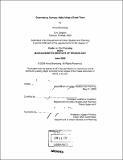| dc.contributor.advisor | Lawrence Susskind. | en_US |
| dc.contributor.author | Bromberg, Anna (Anna Miriam) | en_US |
| dc.contributor.other | Massachusetts Institute of Technology. Dept. of Urban Studies and Planning. | en_US |
| dc.coverage.spatial | n-us-ks | en_US |
| dc.date.accessioned | 2009-11-06T16:20:44Z | |
| dc.date.available | 2009-11-06T16:20:44Z | |
| dc.date.copyright | 2009 | en_US |
| dc.date.issued | 2009 | en_US |
| dc.identifier.uri | http://hdl.handle.net/1721.1/49692 | |
| dc.description | Thesis (M.C.P.)--Massachusetts Institute of Technology, Dept. of Urban Studies and Planning, 2009. | en_US |
| dc.description | Includes bibliographical references (p. 98-104). | en_US |
| dc.description.abstract | The tornado that hit Greensburg, Kansas, in May 2007, traveled down the center of Main Street at two hundred and five miles per hour and destroyed ninety-five percent of the town's built environment. The extensive damage was devastating to a town that was already struggling with job loss, depopulation, and economic decline. When Greensburg unexpectedly announced it would rebuild green, the town captured national attention as a symbol of a sustainable revitalization strategy. This thesis examines Greensburg's recovery with the hope of identifying how other cities can learn from its example. For Greensburg, rebuilding green means creating a healthy future for the next generation. Greensburg interprets green to not only signify environmental conservation, but also, if not more importantly, a strategy for community development and economic stability. Greensburg is fortunate to have visionary leadership and outside financial assistance, but these factors alone would not have been enough to resurrect the town. Greensburg is rebuilding green for its community's future, but in order to rebuild at all, Greensburg first needed the support of its community. Before the storm, the greater Greensburg community was not especially involved in civic affairs or environmental issues. The community became invested in its future and committed to green as a result of three key factors, all of which can be implemented elsewhere. | en_US |
| dc.description.abstract | (cont.) The combination of the extensive environmental education efforts, the growing excitement for reversing the town's decline and the term 'green's ability to resonate with a wide range of interests, encouraged Greensburg residents and business owners to return to the town and inspired them to rebuild green. Greensburg's strategic application of green planning is relevant not only to other small, rural towns, but also to any city that is considering revitalizing a neighborhood. Greensburg integrated green elements into almost every aspect of its recovery. By building weather-resistant, energy efficient buildings and renewable energy infrastructure, instituting new green building policies and pursuing green manufacturing businesses to provide employment opportunities, among many initiatives, Greensburg is using green to create a long-term plan for the town, in order to serve both its natural resources and its community. | en_US |
| dc.description.statementofresponsibility | by Anna Bromberg. | en_US |
| dc.format.extent | 107 p. | en_US |
| dc.language.iso | eng | en_US |
| dc.publisher | Massachusetts Institute of Technology | en_US |
| dc.rights | M.I.T. theses are protected by
copyright. They may be viewed from this source for any purpose, but
reproduction or distribution in any format is prohibited without written
permission. See provided URL for inquiries about permission. | en_US |
| dc.rights.uri | http://dspace.mit.edu/handle/1721.1/7582 | en_US |
| dc.subject | Urban Studies and Planning. | en_US |
| dc.title | Greensburg, Kansas : rebuilding a green town | en_US |
| dc.title.alternative | Rebuilding a green town | en_US |
| dc.type | Thesis | en_US |
| dc.description.degree | M.C.P. | en_US |
| dc.contributor.department | Massachusetts Institute of Technology. Department of Urban Studies and Planning | |
| dc.identifier.oclc | 436228463 | en_US |
